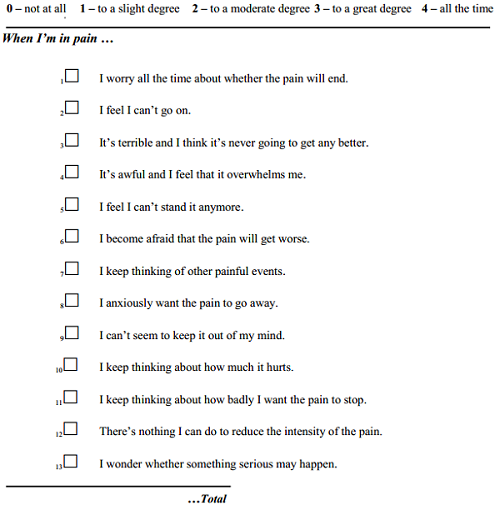Pain Catastrophizing Scale: Difference between revisions
Evan Thomas (talk | contribs) No edit summary |
Evan Thomas (talk | contribs) mNo edit summary |
||
| Line 26: | Line 26: | ||
== Method of Use == | == Method of Use == | ||
[[Image: | [[Image:PCS Q.png|center|500x510px|PCS Questionnaire]]<br> | ||
People are asked to indicate the degree to which they have the above thoughts and feelings when they are experiencing pain using the 0 (not at all) to 4 (all the time) scale. Responses to the 13 questions are then totaled. | People are asked to indicate the degree to which they have the above thoughts and feelings when they are experiencing pain using the 0 (not at all) to 4 (all the time) scale. Responses to the 13 questions are then totaled. | ||
<br> | |||
== Evidence == | == Evidence == | ||
Revision as of 23:45, 13 March 2014
Original Editor - Evan Thomas
Top Contributors - Evan Thomas, Kim Jackson, Admin, Scott Buxton, WikiSysop and Melissa Coetsee
Summary[edit | edit source]
Pain catastrophizing is characterized by the tendency to magnify the threat value of a pain stimulus and to feel helpless in the presence of pain, as well as by a relative inability to prevent or inhibit pain-related thoughts in anticipation of, during, or following a painful event.[1]
Pain catastrophizing affects how individuals experience pain. Sullivan et al 1995 state that people who catastrophize tend to do three things, all of which are measured by this questionnaire.
- They ruminate about their pain (e.g. "I can´t stop thinking about how much it hurts")
- They magnify their pain (e.g. "I´m afraid that something serious might happen")
- They feel helpless to manage their pain (e.g. "There is nothing I can do to reduce the intensity of my pain")
As such, the PCS was developed to help quantify an individual's pain experience, asking about how they feel and what they think about when they are in pain. Compared to other ways of measuring pain-related thoughts, this questionnaire is unique in that the individual does not need to be in pain while completing it.
It is one of the most widely used instruments for measuring catastrophic thinking related to pain, and is used extensively in clinical practice and in research.[2]
Intended Population[edit | edit source]
Method of Use[edit | edit source]
People are asked to indicate the degree to which they have the above thoughts and feelings when they are experiencing pain using the 0 (not at all) to 4 (all the time) scale. Responses to the 13 questions are then totaled.
Evidence[edit | edit source]
Reliability[edit | edit source]
Validity[edit | edit source]
Responsiveness[edit | edit source]
Recent Related Research (from Pubmed)[edit | edit source]
Failed to load RSS feed from http://www.ncbi.nlm.nih.gov/entrez/eutils/erss.cgi?rss_guid=10mYP7P18fg90rFPYVgTfbylj7CKSNRNJ347UmYJ98zLe6GYJy|short|max=5: Error parsing XML for RSS
References[edit | edit source]
- ↑ Quartana PJ, Campbell CM, Edwards RR. Pain Catastrophizing: A Critical Review. Expert Rev Neurother, 2009: 9(5); 745-58.
- ↑ The Development of the Pain Catastrophizing Scale: http://sullivan-painresearch.mcgill.ca/pcs.php







